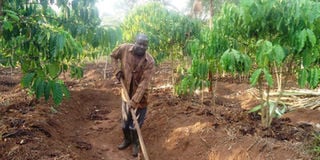President’s advice was what inspired me to start farming

Kintu clears a water channel in his coffee plantation. Besides coffee, he also grows sweet bananas, keeps bees and rears pigs. Photo by Fred Muzaale
My name is Kalafa Mwanje Kintu, a resident of Bukujju village, Kayunga Sub-county, Kayunga District. I am an organic coffee farmer with a plantation of two and a half acres. I also do bee-keeping, own an acre of sweet banana, and a piggery with seven pigs.
Before I started farming in 2010, I was a volunteer mobiliser in the Kayunga RDC’s office. Since I was just a volunteer, I was not being paid. This kept me poor because I spent most of my time in that office. My children did not go to good schools and my family’s standard of living was low.
Getting started
In 2010, during the presidential campaigns, President Museveni talked about how each household could earn at least Shs20m a year. That this would be possible if each household had two acres of coffee, an acre of banana and a dairy cow.
Since we had family land, I decided to give the president’s advice a try. I went to then Kayunga RDC, Margret Balyehuki, and told her about my plan. She was happy with the idea and asked the district Naads officials to avail me with 1,000 coffee seedlings.
I prepared the land and dug pits of two by two feet, and put in farmyard manure to enhance soil fertility. I used a spacing of nine by nine feet between the plants to accommodate 1,000 of them. I also dug water channels and terraces to deal with rainwater run off.
Since I planted my coffee in a dry season, I watered them until the rains started. I also planted grass at the edges of the garden to control soil erosion.
When the plants were about one and a half feet tall, I bent the branches. Doing this makes it produce many branches at those spots. This means more yields per plant. However, when the plant produces many branches, a farmer should ensure that they are trimmed regularly.
I also mulched with grass to control erosion, conserve the soil and add manure when the mulches decompose. In addition, I planted trees to provide shade to protect the coffee plants. The trees are those that allow at least 50 per cent light to reach the coffee plants.
For fertiliser, I make compost manure by digging a pit in the garden.
Beekeeping
When the coffee trees started flowering I placed 10 bee-hives in the plantation not only to get honey but to aid pollination of the coffee flowers.
Effective pollination is crucial as it determines the amount a farmer harvests. If the pollination is not effective, the yields would be low.
From the bee-hives, I get 100 litres of honey every six months. I sell each litre at Shs15,000. My customers are honey processors in Kayunga District.
Sweet bananas
This enterprise is one acre and has 400 plants. I planted the traditional sweet banana variety, which is liked by consumers. I sell a big bunch at Shs7,000-Shs8,000. In a month, I harvest about 20 bunches.
Coffee harvest
Last year I harvested 5,000 kg of unprocessed coffee (kiboko). After processing, I got 2,500kg of processed coffee (kase). Each kilo of kase went for Shs5,000 and I earned Shs12m. I sold to traders who have buying centres at coffee processing factories. I used the husks as manure in the garden. Because I harvest only ripe cherries, my coffee is of high grade.
Next year, I expect to earn at least Shs15m and, in four years, when the trees are fully mature, I hope to reach the Shs20m annual income the president talked about.
Because my plantation is well managed, I often get many visitors including those from Uganda Coffee Development Authority (UCDA), who come to visit it and also use it as a demonstration for other farmers.
Since my coffee is organic, representatives from foreign companies that buy coffee have also visited my plantation and have promised to buy my coffee beans at a higher price.
I do most of the farm work with my wife and children. Because of this I don’t spend any money on labour.
Challenges
The biggest challenge is the coffee wilt disease. On average, I lose about two coffee trees every month. This disease has no cure, so we check the spread by cutting and burning the affected plants.
Recently, I tried a method of applying paraffin on the stumps. I am still testing this method but it has proved to work.
The stem borer pest is another challenge. This is because when the borer drills a hole in the branches, enters to feed on them, which causes them to dry.
I try to control this pest by cutting the affected branches and burning to kill the pests.
Yet another challenge is dry seasons. During such periods, I have to water the coffee trees so that they do not dry up. Watering two acres every three days is laborious though I get the water nearby.
Achievements
My biggest achievement is that I am now able to look after my family well. Because I have a well-maintained plantation, it is easy to get loans from coffee buyers whom I pay after harvest.
Future plans
I want to buy a mill and start milling maize. I hope to pack the flour and sell it to super markets. This will diversify my income.
I plan to get two dairy cows under zero grazing. The cows will give me milk and I will use the dung for fertiliser.
In addition, my intention is to expand the coffee and banana plantations. This will earn me more money, from which I plan to buy a manually-operated machine that processes raw coffee, which will boost the quality.




